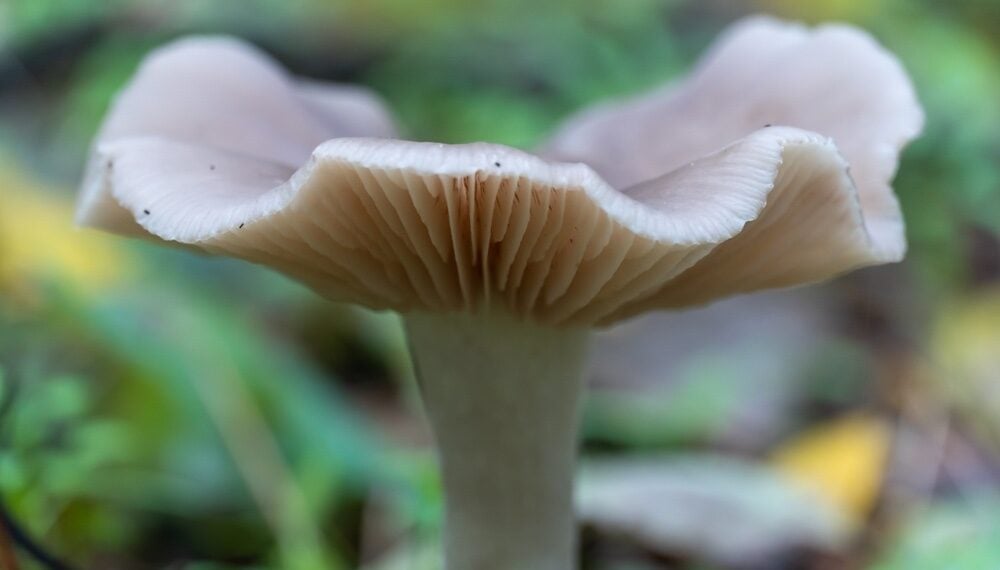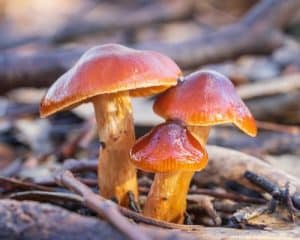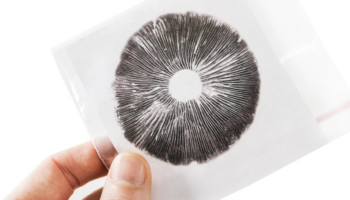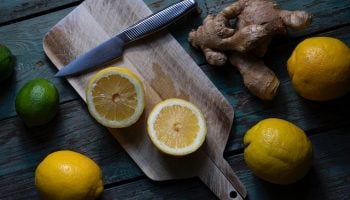Disclaimer: Psychedelics are largely illegal substances, and we do not encourage or condone their use where it is against the law. However, we accept that illicit drug use occurs and believe that offering responsible harm reduction information is imperative to keeping people safe. For that reason, this document is designed to enhance the safety of those who decide to use these substances.
This article has been medically reviewed by Katrina Oliveros, MSN-ED, BSN
Maria Katrina, is a trauma-informed Wellness Educator and Psychedelic Harm Reduction Consultant. Beyond nursing, she supports health & wellness teams through medical aid, psychedelic harm reduction, and integration services.
Psilocybe cyanescens is a species of psychedelic mushroom that mainly grows in the Pacific Northwest and parts of Europe and Asia. P. cyanescens is also called “Wavy Caps” due to their large brownish wave-shaped caps. They are a highly potent species known to have strong psychedelic effects.
This article will guide you through Psilocybe cyanescens mushrooms and review their history, culture, psychedelic effects, and benefits.
What Are Psilocybe cyanescens Mushrooms?
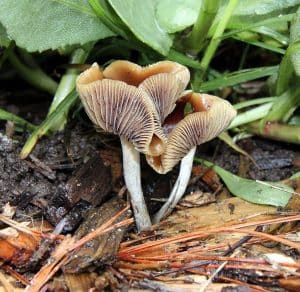
Psilocybe is an extensive mycelial genus with unique species, including the famous Psilocybe cubensis.
Many other Psilocybe species grow worldwide, differing in potency and the psychedelic experience they offer. There are more than 180 mushroom species containing psilocybin, which all have a rich history and traditional use for spiritual and religious purposes.
Psilocybe cyanescens is a species of hallucinogenic mushrooms that mainly grows in North America, Western and Central Europe, New Zealand, and Iran. In the United States, P. cyanescens grow abundantly in Oregon.
The mushrooms are saprophytic, meaning their habitat consists of dead material. They often grow on rotting wood, wood-chip mulch, and sawdust.
4 Ways To Identify Psilocybe cyanescens “Wavy Cap” Mushrooms
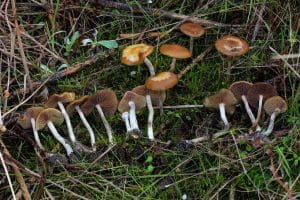
Photo credit: Alan Rockefeller (Alan Rockefeller) at Mushroom Observer, a source for mycological images
Identifying psychedelic mushrooms is not always easy. Still, each species has unique features that will help you recognize the mushroom type.
Foraging is a fun and adventurous way of finding psychedelic mushrooms. However, you need to have a solid knowledge of various species before doing so. If you are into foraging for magic mushrooms, learn how to identify them outdoors.
In the case of Psilocybe cyanescens mushrooms, there are some main features you should look for to ensure you don’t mistake them for poisonous species.
Grow 1 Year's Worth of Microdoses in Just 6 Weeks
Third Wave partnered with top mycologists to create the world’s easiest and best mushroom growing program (kit, course, and expert support).
- Pre-sterilized and sealed
(ready to use out of the box) - Step-by-step video and text course
- Access to growing expert in community
- Make your first harvest in 4-6 weeks
- Average yield is 1 - 4 ounces (28-108g)
- Fits in a drawer or closet
- Enter info for Third Wave discounts:
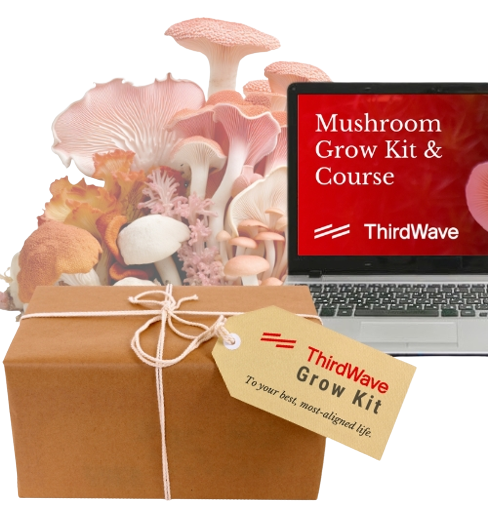
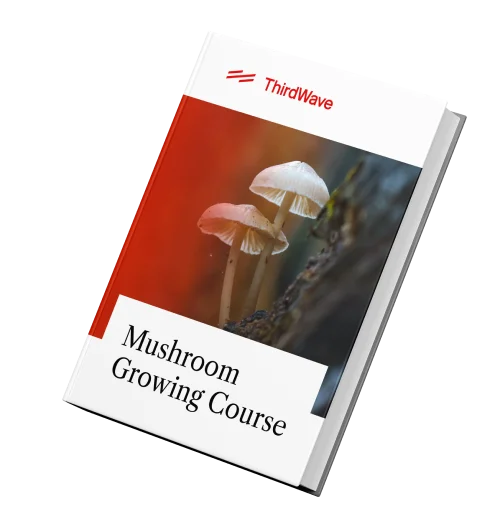
Grow 1 Year's Worth of Microdoses in Just 6 Weeks
Third Wave partnered with top mycologists to create the world’s easiest and best mushroom growing program (kit, course, and expert support).
- Pre-sterilized and sealed
(ready to use out of the box) - Step-by-step video and text course
- Access to experts in community
- Make your first harvest in 4-6 weeks
- Average yield is 1 - 4 ounces (28-108g)
- Fits in a drawer or closet
- Enter info for Third Wave discounts
Are Psilocybe cyanescens Mushrooms Psychedelic?
Yes, Psilocybe cyanescens are psychedelic mushrooms.
Psilocybe cyanescens contain three hallucinogenic compounds known as tryptamines: psilocybin, psilocin, and baeocystin. [1], [2]. These compounds bind to serotonin receptors to elicit their trademark effects.
The North American species contain between 0 -1.68 percent psilocybin and 0.06 – 0.96 percent psilocin, according to analyses by Beug and Bigwood in 1982 [11].
Effects of Taking Wavy Cap Mushrooms
Common effects of psilocybin include changes in emotional, cognitive, and physiological processes.
- Increased mood and happiness
- Increased empathy
- Enhanced mood and euphoria
- Introspection
- Visual hallucinations
- Increased creativity and flow states
- Physiological changes, e.g., nausea, dilated pupils, dizziness
Since all mushroom species are unique in their potency and effects, the experience with P. cyanescens might not be the same as others. Furthermore, the mushroom experience is highly dose-dependent and subjective.
Wavy Caps are more potent than Psilocybe cubensis mushrooms. High doses of this strain can induce intense spiritual and mystical experiences.
Based on anecdotal evidence, a psychedelic trip with Wavy Caps is powerful and intense. A psychonaut describes the mushroom as “a light DMT experience.” Another psychedelic explorer describes the experience as “Visual, stunning, and potent.”
Cognitive Effects
The cognitive effects often start in 30 minutes to an hour, and the overall duration of the trip may be between four and ten hours.
- Auditory hallucinations
- Strong visuals
- Alterations in perception
Emotional Effects
- Positive mood
- Peace, awe, and joy
- Anxiety, fear, dread
- Gratitude
- Feeling of unity
- Sacredness
- Mystical experiences
Physiological Effects
- Strong body high
- Nausea
- Dilated pupils
- Trouble with coordination
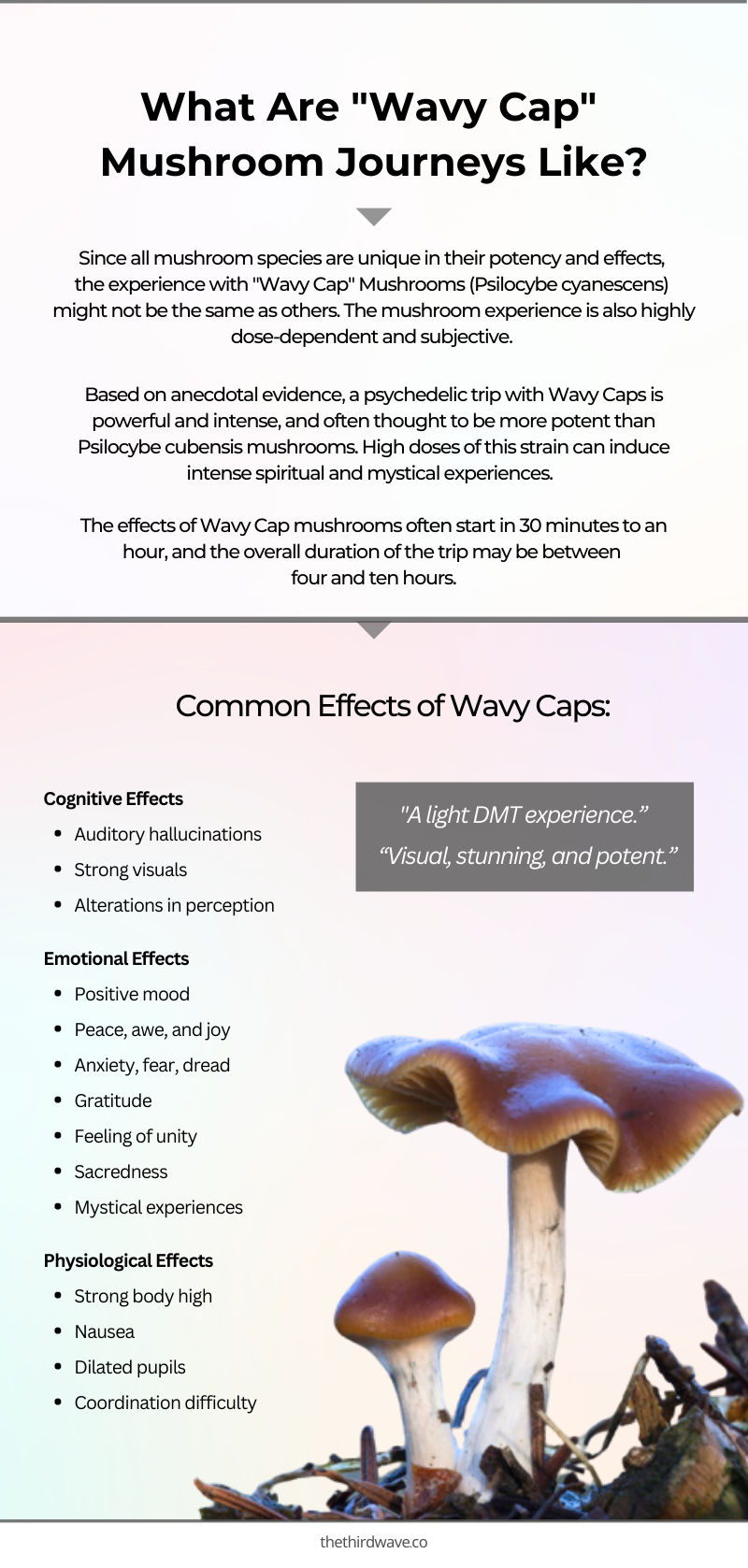
How Do You Grow Psilocybe Cyanescens?
Disclaimer: Growing psilocybin mushrooms for consumption is a potentially illegal activity, and we do not encourage or condone this activity where it is against the law.
Psilocybe cyanescens mushrooms love cold weather. Outdoor growing is relatively easier with P. cyanescens; however, indoor cultivation is possible if you can manage the right temperatures. These mushrooms can grow in gardens and will most likely prefer to be around wood chips [12].
Explore Third Wave’s mushroom grow kit and learn more about cultivating psilocybin mushrooms on your own. Alternatively, read our article on legally sourcing psychedelic medicines around the world.
What Conditions Are Required To Cultivate Psilocybe cyanescens?
Wavy Cap mushrooms love cold weather. The fruiting of these mushrooms occurs in fall when the temperature drops.
The condition and materials needed to cultivate Wavy Caps are the following:
- Temperatures between 10–18 °C (50-64 Fahrenheit)
- Alder chips (Alnus rubra) or any other wood material, e.g., fire pallets
- Spore prints and spore syringes
Harvesting techniques and tips
Main cultivation techniques for other species also apply to P. cyanescens with minor differences. If you want to harvest your own magic mushrooms, read our article on how to grow psychedelic mushrooms.
Some specific tips for P. cyanescens based on forums:
- Mycelium is easier to grow than fruiting bodies.
- Mycelium is also enough for transplantation (moving into another area).
- They like to grow in shaded and moist spaces.
- They like cold temperatures.
Legality of Growing Magic Mushrooms
Mushroom spores do not contain psilocybin or psilocin. Therefore, purchasing them is considered to be legal. Magic mushroom spores are permitted in the United States, except for California, Georgia, and Idaho.
Be mindful about the legality of magic mushrooms where you live to avoid any potential issues.
Once you have your mushroom spores, explore Third Wave’s Magic Mushroom Grow Kit to grow your mushrooms without any risk or concerns.
Grow 1 Year's Worth of Microdoses in Just 6 Weeks
Third Wave partnered with top mycologists to create the world’s easiest and best mushroom growing program (kit, course, and expert support).
- Pre-sterilized and sealed
(ready to use out of the box) - Step-by-step video and text course
- Access to growing expert in community
- Make your first harvest in 4-6 weeks
- Average yield is 1 - 4 ounces (28-108g)
- Fits in a drawer or closet
- Enter info for Third Wave discounts:


Grow 1 Year's Worth of Microdoses in Just 6 Weeks
Third Wave partnered with top mycologists to create the world’s easiest and best mushroom growing program (kit, course, and expert support).
- Pre-sterilized and sealed
(ready to use out of the box) - Step-by-step video and text course
- Access to experts in community
- Make your first harvest in 4-6 weeks
- Average yield is 1 - 4 ounces (28-108g)
- Fits in a drawer or closet
- Enter info for Third Wave discounts
Microdosing Psilocybe cyanescens mushrooms
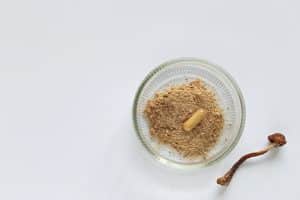
Microdosing magic mushrooms means consuming them in sub-perceptual proportions. The dosage for microdosing psilocybin is often around 0.1-0.3 g. However, the optimal dosage varies a lot depending on the strain of mushroom, its potency, and the consumer’s tolerance.
Microdosing P. cyanescens can offer some potential benefits such as:
- Improved mood
- Enhanced creativity
- Alleviated anxiety
- Increased connectedness
Learn the essentials about microdosing psilocybin through our ultimate microdosing guide.
Benefits & Risks of Taking Psilocybe cyanescens mushrooms
P. cyanescens mushrooms are quite potent in their psilocybin and psilocin levels, which initiate shifts in consciousness. Therefore, the mushroom carries potential healing benefits along with some risks.
Benefits
Psychedelic mushrooms are known for their healing and transformational effects. The various benefits of psilocybin mushrooms include:
- Life-altering experiences, spiritual and transformational changes
- Potential therapeutic properties for mental health disorders e.g., depression and anxiety
- Increased creativity
- Flow experiences (See: psychedelics and flow states)
- Improved mood and energy
Learn more about the benefits of magic mushrooms.
Risks
Psilocybin has a low potential for addiction, abuse, dependance, and toxicity. However, there are some other risks of taking psilocybin-containing mushrooms. They can cause some severe physical effects such as nausea, vomiting, and tremors. Beyond physiological changes, they can also induce anxiety, panic attacks, fear, and paranoia.
To eliminate the potential risks, it is crucial to know the big three of a psychedelic trip: dosing, set, and setting.
Therapeutic Potential of Psilocybe Cyanescens
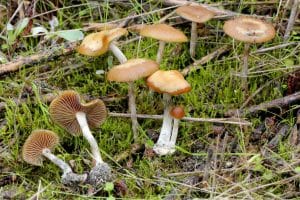
Photo credit: Alan Rockefeller (Alan Rockefeller) at Mushroom Observer, a source for mycological images
The healing properties of psilocybin have been used in different indigenous cultures. Now contemporary research and studies of psilocybin show its clinical potential to treat various conditions, such as depression, anxiety, addiction, and post-traumatic stress disorder.
Various clinical trials are currently studying the therapeutic use of psilocybin at the US National Institutes of Health (NIH).
Psilocybin can also facilitate self-improvement. Indeed, various self-reports indicate drastic changes in people’s personality traits, beliefs, and lifestyles after having experience with psilocybin mushrooms.
Are Wavy Cap Mushrooms Legal?
Psilocybin is an illegal substance in many countries and is classified as a Schedule I substance under the federal Controlled Substances Act. Only some forms are legal in the Netherlands (magic truffles), Brazil, the British Virgin Islands, and Jamaica. P. cyanescens and its cultivation are illegal in many countries.
Read our article on the legality of magic mushrooms.
If you want to work with psilocybin medicine, check out Third Wave’s Directory to discover legal retreat centers worldwide.
Wavy Cap Mushroom Legality in the United States
The use of psilocybin remains illegal in the United States. However, several states have decriminalized possession, including Colorado, Washington, and Massachusetts.
In Oregon, possessing and using psilocybin for therapeutic purposes has been legalized since 2020.
With rising research and developments in the field of psychedelic therapy, the laws around psilocybin can change soon. More states and countries may be easing the restrictive laws around psychedelics and allowing psilocybin to become a part of mainstream therapy.
Final Thoughts on Psilocybe cyanescens…
Psilocybe cyanescens is a lesser-known hallucinogenic mushroom with a wavy-cap look. Experiences with Wavy caps can be highly spiritual, mystical, and intense due to the strain’s potency.
It is crucial to distinguish this mushroom strain from its poisonous look-alikes, such as Galerina and Conocybe.
To sum up, psilocybin is a substantial psychedelic substance with various benefits; each species has unique qualities. Experiences with magic mushrooms are life-altering and highly transformational events that cause significant changes in individual lives. If you are keen to experiment with psilocybin, familiarize yourself with the nature of the psychedelic experience and its essential notions, such as set and setting.
Home growing is one of the best ways to experiment with mycelial species like Wavy Caps. Start cultivating your own mushrooms today with Third Wave’s Mushroom Grow Kit.
Grow 1 Year's Worth of Microdoses in Just 6 Weeks
Third Wave partnered with top mycologists to create the world’s easiest and best mushroom growing program (kit, course, and expert support).
- Pre-sterilized and sealed
(ready to use out of the box) - Step-by-step video and text course
- Access to growing expert in community
- Make your first harvest in 4-6 weeks
- Average yield is 1 - 4 ounces (28-108g)
- Fits in a drawer or closet
- Enter info for Third Wave discounts:


Grow 1 Year's Worth of Microdoses in Just 6 Weeks
Third Wave partnered with top mycologists to create the world’s easiest and best mushroom growing program (kit, course, and expert support).
- Pre-sterilized and sealed
(ready to use out of the box) - Step-by-step video and text course
- Access to experts in community
- Make your first harvest in 4-6 weeks
- Average yield is 1 - 4 ounces (28-108g)
- Fits in a drawer or closet
- Enter info for Third Wave discounts
FAQ
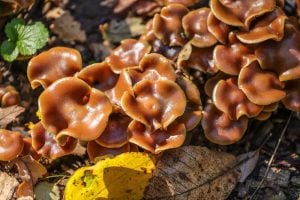
Is P. cyanescens more potent than P. cubensis?
Yes. P. cyanescens mushrooms tend to be more potent than P. cubensis.
Read our article, where we compared the top five strains of magic mushrooms, to learn more about their potencies.
Do Psilocybe cyanescens have look-alikes?
Some species look quite similar to P. cyanescens mushrooms, and some are known to be dangerous in effect. Therefore, it is crucial to distinguish them.
Galerina marginata
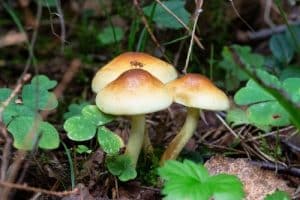
The most important one might be the Galerina marginata – a fatal poisonous species. These two mushrooms have similar-shaped brown caps and sometimes share the same habitat.
The significant difference is that Galerina marginata does not bruise blue when picked – the bruising feature is characteristic of psilocybin-containing mushrooms. Therefore, this is the initial thing to look for. They also have distinct colored spores.
- Leratiomyces ceres
L. ceres is a poisonous species and can be easily mixed with P. cyanescens due to their brown caps and white stems. The difference is that L. ceres has gray gills and orange-red or yellow stems.
- Psilocybe semilanceata (aka. Liberty Cap)
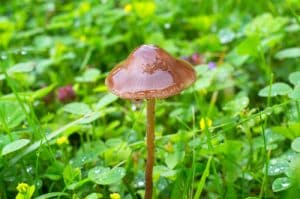
Liberty caps and Wavy caps are similar in their hallucinogenic concentrations. However, P. semilanceata mainly grows in grass and has a pointed-conical cap.
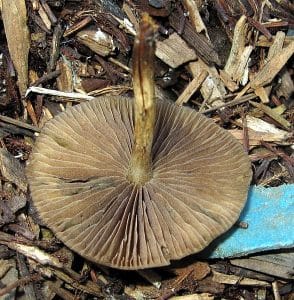
Photo credit: Image Number 120577 at Mushroom Observer
This species is similar to cyanescens, as they grow on wood chips. The easier way to distinguish these two is their cap margin. P. allenii mushrooms have a more convex-shaped cap.
- Conocybe tenera
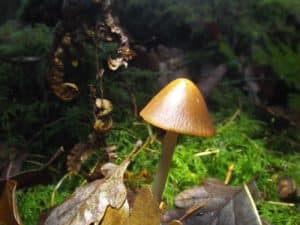
Another saprotrophic mushroom, Conocybe tenera, likes dead and organic substrates. Even though they look similar to P. cyanescens, they have differences in caps and spore prints.
They have more conic-convex caps, contrary to the wavy caps of cyanescens. Further, their spores are more yellowish.
Do P. cyanescens have related species?
Yes. Wavy Caps have phylogenetically related species, called “Psilocybe cyanescens complex” since they have extreme similarities in appearance and environment [1]. The complex includes the following species [13]:
- P. cyanescens
- P. azurescens
- P. serbica
Is Panaeolus cyanescens the same as Psilocybe cyanescens?
No, they are not the same mushroom species.
These two species differ in their look, growing and living conditions, as well as their psychedelic effects.
Panaeolus cyanescens (also called “Blue Meanies”) is a psychoactive mushroom species often found in South America, Western Europe, Central Africa, South and Southeast Asia, and Oceania [14].
Panaeolus species belong to the Bolbitiaceae family. They grow mainly in tropical areas and have more convex-shaped caps compared to P. cyanescens.
Panaeolus cyanescens is considered one of the most potent mushrooms known, containing 3.7% psilocybin and psilocin.
Where to find P. cyanescens mushrooms in the United States?
P. cyanescens mushrooms can be found on the west coast of the USA, specifically in the Pacific Northwest and San Francisco Bay Area.
If you intend to work with psilocybin mushrooms, look over the Third Wave’s legal psilocybin mushroom retreats worldwide.
You want to grow your own mushrooms but not sure where to begin? Check out Third Wave’s Mushroom Grow Kit to learn the whole process of cultivating magic mushrooms.
Grow 1 Year's Worth of Microdoses in Just 6 Weeks
Third Wave partnered with top mycologists to create the world’s easiest and best mushroom growing program (kit, course, and expert support).
- Pre-sterilized and sealed
(ready to use out of the box) - Step-by-step video and text course
- Access to growing expert in community
- Make your first harvest in 4-6 weeks
- Average yield is 1 - 4 ounces (28-108g)
- Fits in a drawer or closet
- Enter info for Third Wave discounts:


Grow 1 Year's Worth of Microdoses in Just 6 Weeks
Third Wave partnered with top mycologists to create the world’s easiest and best mushroom growing program (kit, course, and expert support).
- Pre-sterilized and sealed
(ready to use out of the box) - Step-by-step video and text course
- Access to experts in community
- Make your first harvest in 4-6 weeks
- Average yield is 1 - 4 ounces (28-108g)
- Fits in a drawer or closet
- Enter info for Third Wave discounts
References
[1] Arora, D. (1986). Mushrooms demystified. Ten Speed Press.
[2] Gartz, J. O. C. H. E. N. (1996). Observations on the Psilocybe cyanescens complex of Europe and North America. Ann. Mus. Civ. Rovereto, 12, 209-218.
[3] Rumack, B. H., & Spoerke, D. G. (1994). Handbook of mushroom poisoning: diagnosis and treatment. CRC press.
[4] Stamets, P. (1996). Psilocybin mushrooms of the world: an identification guide. Ten Speed Press.
[5] Shaw, P. J., & Kibby, G. (2001). Aliens in the flowerbeds: the fungal biodiversity of ornamental wood chips. Field mycology, 2(1), 6-11. https://doi.org/10.1016/S1468-1641(10)60081-3
[6] Stamets, P. (2011). Growing gourmet and medicinal mushrooms. Ten-speed press.
[7] Samorini, G. (1992). The oldest representations of hallucinogenic mushrooms in the world (the Sahara Desert, 9000-7000 BP). Integration, 2(3), 69-78.
[8] Carod-Artal, F. J. (2015). Hallucinogenic drugs in pre-Columbian Mesoamerican cultures. Neurología (English Edition), 30(1), 42-49. https://doi.org/10.1016/j.nrleng.2011.07.010
[9] Berlant, S. R. (2005). The ethnomycological origin of Egyptian crowns and the esoteric underpinnings of Egyptian religion. Journal of Ethnopharmacology, 102(2), 275-288. https://doi.org/10.1016/j.jep.2005.07.028
[10] Dennis, R. W. G., & Wakefield, E. M. (1946). New or interesting British fungi. Transactions of the British Mycological Society, 29(3), 141–166. https://doi.org/10.1016/S0007-1536(46)80038-X
[11] Beug, M. W., & Bigwood, J. (1982). Psilocybin and psilocin levels in twenty species from seven genera of wild mushrooms in the Pacific Northwest, U.S.A. Journal of ethnopharmacology, 5(3), 271–285. https://doi.org/10.1016/0378-8741(82)90013-7
[12] Nicholas, L. G., & Ogame, K. (2006). Psilocybin mushroom handbook: easy indoor & outdoor cultivation. Ed Rosenthal.
[13] Borovička, J., Noordeloos, M. E., Gryndler, M., & Oborník, M. (2011). Molecular phylogeny of Psilocybe cyanescens complex in Europe, with reference to the position of the secotioid Weraroa novae-zelandiae. Mycological Progress, 10, 149-155. DOI:10.1007/s11557-010-0684-3
[14] Gerhardt, E. (1987). Panaeolus cyanescens (Bk. & Br.) Sacc. und Panaeolus antillarum (Fr.) Dennis, zwei adventivarten in Mitteleuropa. Beiträge Kenntnis Pilze Mitteleuropas, 3, 223-227.

